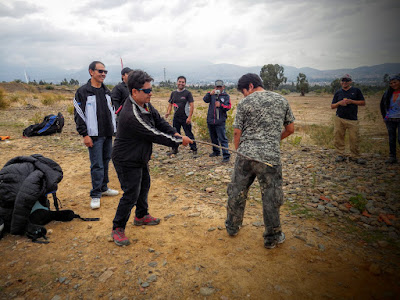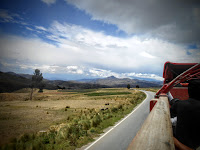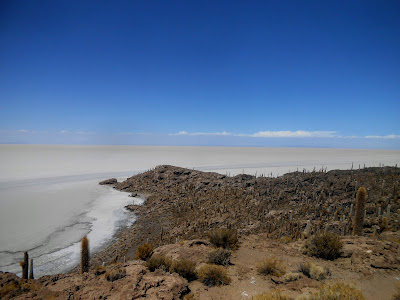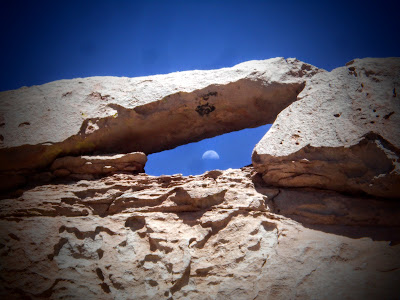Back to the writing after a long period passed far from the computer screens. Not easy to keep a writing rythm and sometimes it is good to take a break :) .
Anyway, back from my Uyuni tour my goal was to get to Cochabamba where Geo was spending some time looking for a job for the future. On my way I decided to make a few stops.
First I stopped in one of the most historical city of Bolivia: Potosi.
Potosi is a relatively small city situated in the south of Bolivia in the so-called Bolivian Tin-Belt, the city itself is located at the impressive altitude of 4067 m.a.s.l. making Potosi one of the highest cities in the world.
The city is known for its mining activity, indeed Potosi is home to the Cerro Rico (litteraly rich mountain) which is the world's largest silver depot. Potosi has been mined since the sixteenth century continually which transformed the surroundings of the mountain in large gravel stocks and old derelict mining plants and machinery.
 |
| Potosi and the Cerro Rico |
A bit of history.
After the arrival of the Spanish Conquistadors and the change of the little Andes hamlet into a big mining centre Potosi became the major colonial-era supplier of silver for Spain. Potosí was directly and tangibly associated with the massive import of precious metals to Seville, which precipitated a flood of Spanish currency and resulted in globally significant economic changes in the 16th century.
By the 17th century Potosi had become one of the largest cities in the world relying on the work of Spanish colons and more importantly indigenous slaves forced to work in the mines.
By the end of the 19th century low silver prices prompt the change to mining tin. The mine worked till 1985 when the tin market crashed leading to massive layoffs in miners.
Now the mines are working under a cooperative system. Each mine or "hole" in the mountain belong to a cooperative and the miners are shareholders in their cooperative. The work is still really hard and even harder than it was a few decades ago as the ores contain less and less of the wanted minerals and require to go deeper and deeper.
 |
| Cerro Rico's minerals |
My idea in Potosi was to try to fly off from the famous Cerro Rico. I thought that once again it would give me the opportunity to see the place from a different perspective. The other reason is that I didn't want to be part of one of these mine tours that basically take you down the rat holes while people are working (and often childrens). For me this was voyeurism tourism. A big group of wealthy tourist going down the mine for an hour to take pictures of the poor miners, hmmm is this really right?!? In the mean time it is the good occasion to make a reality check. Anyway I decided not to go and to go looking for a take off instead.
 |
| Cerro Rico |
The day was nice and clear, but the wind and the thermal didn't seem to be on my side. Moreover the big stack of mine rejects and old mining instalation that is Potosi didn't seem to be the nicest environment for a flight. As I was climbing into the mining area a miner came to speak to me. He offered me to take me in the mines for less than half the price the mining tours are asking. Hmm I hesitated, I was there and furthermore it was Sunday, the resting day, so no miner would be down in themines working. After a last bargaining on the price I decided to go.
I went down with Jonnie a young miner that was already father of three kids.
 |
| Getting into the mine |
Jonnie took me around for a quick tour in the mine. Not much time down there was necessary to realize how hard the work conditions are. Moving up and down the galleries was challenging and involved climbing. Not the easiest thing with welly-boots about three sizes too short.
Sometimes we had to pass under stacks of rocks in order to continue. Thousands of tons retained by a few planks...
It was like caving but in a man made environment. It is just incredible to think that some guys are working six days a week for the whole day drilling and carrying rocks by hand in 2015.
Jonnie showed me the mine God called the "Tio". Apparently the Tio has been brought to the indigenous people working there by the Conquistadors. The Spanish seeing that many slaves weren't working properly introduced this mine's God to boost up their work by introducing a pressure from an "higher instance". And it worked! The workers started to worship the statue and called it Tio by deformation as they couldn't pronounce properly Dios (God in Spanish). Nowadays even if most of the miners know the origin of the Tio, it is still a key figure of the mine. And the miners get together around the Tio to drink Alcohol (nearly pure alcohol!!) smoke cigarettes and refill in Coca leaves (indispensable for any miner).
 |
| The famous Tio |
The coca leaves are used by the miners for three main reasons (Ihave been told):
1. It helps them with altitude and breathing
2. It stops the hunger
3. It is used as a clock. Every 3 hours the coca leaves are losing their taste it is time to have break and refill.
 |
| Another mine... |
Coming out of the mine I met up with Jonnie's family living there in a little house just by the entry of the mine (about 8 person in one room). When I said I had a paraglider, one of Jonnie's sisters wanted me to take her for a flight. Next time when I'll have my tandem equipment.
Needless to say that it has been quite a mind-blowing experience to see these people's working conditions, I ended up my day by a good walk on the mountain in search for a take off that I never found and thinking on how privileged we are to live in developed countries.
The next stop on my road to Cochabamba was Sucre Bolivia's constitutional capital. I didn't stay long in Sucre as I purchased my ticket to Cochabamba directly in the bus terminal arriving from Potosi. But just as I got into town I already wished I was staying a bit longer.
Sucre is a very pleasant city with beautiful colonial buildings. Walking in the historical centre it is possible to see all the impressive private mansions which have been built by the rich mine owners. The climate is pretty mediterranean.
In Sucre I just walked around enjoying the many churches and squares. Went to the beautiful market to enjoy some very good and varied local food (there actually is some delicious Bolivian food and not only fried chicken!!).
 |
| Sucre Mercado Central |
The I embarked on one of the worst buses of the trip that took me from Sucre to Cochabamb. Don't take the cheap option if it is only 2 dollars less because you don't know what you are getting into! The 8 hours trip transformed into 20 hours trip and we finished the journey on the back of a truck, including young childrens and old ladies!































































































